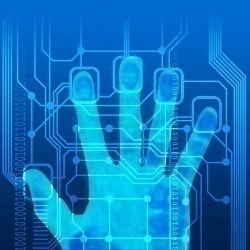Biometrics
Biometrics, or bio-identification, is the practice of measuring physical characteristics of a person to verify their identity.
The most common biometric systems measure fingerprints or hand prints. More advanced biometric systems measure the users voice, features of the users eyes, or the geometry of their entire face. Futuristic systems measure the users ears, their smell, or even their DNA itself.
Biometrics are more secure than passwords, but they can also be fooled. For example, one hacker discovered that fingerprint readers could be fooled by copying a fingerprint using the goo that Gummy Bears are made out of.
Fingerprint Recognition
The most common type of biometrics relies on fingerprint recognition to identify an authorized user. Fingerprint recognition devices use a laser light to scan the crevices in the user’s fingerprint and compare them to an image of the fingerprint that the device has on file.
Voice Recognition
While fingerprint recognition systems use a laser to match a fingerprint’s crevices to a stored image, voice recognition systems use a microphone to compare tone and pitch patterns in the user’s voice with a stored audio file. Voice recognition and fingerprint recognition may be used in conjunction on the same system for additional security.
Optical Recognition
In addition to fingerprint and voice recognition systems, some systems use an even higher level of security by depending on optical recognition. Optical recognition systems, like fingerprint recognition systems, use a low level laser light to scan the user’s eye and compare his/her iris and retinal characteristics with an image stored on file. Since an individual’s eye has more characteristics to identify than a fingerprint or voice pattern, optical recognition systems are considered to be much more secure than other forms of biometrics. Optical recognition can also be used in conjunction with fingerprint and voice recognition systems in order to maximize security.
Challenges for Biometrics
Adoption of biometrics has been slow, for several reasons:
- False negatives – A user who cut his finger is suddenly refused access.
- Cost – This hardware and software is significantly more complex and expensive that password or token cards.
- Intrusiveness – Many people feel than being measured is dehumanizing.
Additional Reading on Biometrics
For more information, read the Biometrics FAQ.


Comments - No Responses to “Biometrics”
Sorry but comments are closed at this time.